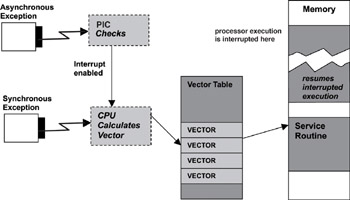Книга: Real-Time Concepts for Embedded Systems
10.5.3 Loading and Invoking Exception Handlers
10.5.3 Loading and Invoking Exception Handlers
As discussed earlier, some differences exist between an ESR and an ISR in the precursory work the processor performs. This issue is caused by the fact that an external interrupt is the only exception type that can be disabled by software. In many embedded processor architectures, external interrupts can be disabled or enabled through a processor control register. This control register directly controls the operation of the PIC and determines which interrupts the PIC raises to the processor. In these architectures, all external interrupts are raised to the PIC. The PIC filters interrupts according to the setting of the control register and determines the necessary action. This book assumes this architecture model in the following discussions.
Formally speaking, an interrupt can be disabled, active, or pending. A disabled interrupt is also called a masked interrupt. The PIC ignores a disabled interrupt. A pending interrupt is an unacknowledged interrupt, which occurs when the processor is currently processing a higher priority interrupt. The pending interrupt is acknowledged and processed after all higher priority interrupts that were pending have been processed. An active interrupt is the one that the processor is acknowledging and processing. Being aware of the existence of a pending interrupt and raising this interrupt to the processor at the appropriate time is accomplished through hardware and is outside the concern of an embedded systems developer.
For synchronous exceptions, the processor first determines which exception has occurred and then calculates the correct index into the vector table to retrieve the ESR. This calculation is dependent on implementation. When an asynchronous exception occurs, an extra step is involved. The PIC must determine if the interrupt has been disabled (or masked). If so, the PIC ignores the interrupt and the processor execution state is not affected. If the interrupt is not masked, the PIC raises the interrupt to the processor and the processor calculates the interrupt vector address and then loads the exception vector for execution, as shown in Figure 10.5.

Figure 10.5: Loading exception vector.
Some silicon vendors implement the table lookup in hardware, while others rely on software approaches. Regardless, the mechanisms are the same. When an exception occurs, a value or index is calculated for the table. The content of the table at this index or offset reflects the address of a service routine. The program counter is initialized with this vector address, and execution begins at this location. Before examining the general approach to an exception handler, let's first examine nested interrupts and their effect on the stack.
- Выражения в EXCEPTION
- Разработка приложений баз данных InterBase на Borland Delphi
- Open Source Insight and Discussion
- Introduction to Microprocessors and Microcontrollers
- Chapter 6. Traversing of tables and chains
- Chapter 8. Saving and restoring large rule-sets
- Chapter 11. Iptables targets and jumps
- Chapter 5 Installing and Configuring VirtualCenter 2.0
- Chapter 16. Commercial products based on Linux, iptables and netfilter
- Appendix A. Detailed explanations of special commands
- Appendix B. Common problems and questions
- Appendix E. Other resources and links




